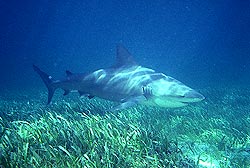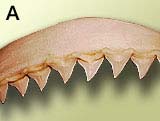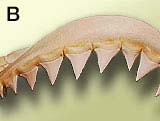
|
|
|
|
|
|
Shark Info (10-15-1999) |
Author |
|
Intro: |
Shark Info |
|
Main article: |
Dr. E. K. Ritter |
|
Article 1: |
Dr. J. F Morrisey |
|
Article 2: |
Shark Info |
|
Article 3: |
Shark Info |
|
Article 4: |
Shark Info |
|
Fact Sheet: |
Dr. E. K. Ritter |
|
Fact Sheet: Bull Sharks
DistributionBull sharks (Carcharhinus leucas) are found in tropical and subtropical waters almost everywhere in the world, whereby they prefer to live close to, or even in rivers. They belong to a minority species, capable of living in sweet water as sexually mature individuals. They are thus found in various rivers such as the Mississippi, the Amazon or the Zambezi. In the Mississipi river they are found all the way up to Illinois, and in the Amazon as far inland as 3,500 km. But whole populations, not just single individuals, also live in such sweet water lakes as Lake Nicaragua or Lake Isabel in Guatemala. Their capability of tolerating varying saltwater levels means they can also be found in brackish water systems, like the Indian River System near Cape Canaveral (Florida). Bull sharks often live so long in sweet water that their metabolism adjusts to the missing salt. Identifying marks and appearanceBull sharks may grow to a length of 350 cm and weigh about 230 kg. Their massive appearance is rather striking. Their short and round snout is a conspicuous feature, and in contrast to other gray shark species from the Carcharhinidae family, bull sharks have very small eyes. Their most noticeable characteristic is, however, the dorsal fin which is shaped like a triangle. The body‘s colors are subdued, with a dark-gray back and a white belly. With pups, the end of the fins are black, but this coloring disappears as they grow older. FeedingBull sharks feed on a wide variety of water animals, including bony fishes, mollusks, crabs and at times even other sharks and rays, for they belong to the few species of sharks with cannabalistic traits. ReproductionLike all other members of the Carcharhinidae family, bull sharks are born alive (viviparous) and the litter may include 1-3 pups. Pregnancy lasts 10 to 11 months. Males reach sexual maturity between 14 and 15 years, females only at about age 18. Although bull sharks do not rear their young like most other shark species, they bear their young in protected coastal areas. It follows that most young bull sharks are found in the flat, coastal regions around the world. These "nurseries" increase their chance of survival. Bull shark youngsters grow slowly and are thus exposed to predators for fairly long periods of time, whereby larger sharks represent the main danger. However, larger predators avoid the flat regions. Exploitation and fishingThis shark species lives primarily in shore areas and coastal regions, and thus often becomes victim to coastal fishing activities. They are primarily caught with long-lines but also frequently turn up as incidental catch. Although bull sharks rank "low" on the list of endangered species (IUCN status: lower risk), (also see article in this issue on shark protection titled "Weak shark protection") it must be assumed that the species will acquire the IUCN status of an endangered species in the foreseeable future, not least because of the increasing destruction of their nurseries by man. AccidentsSince bull sharks often live in rivers or their estuaries, accidents with humans may occur, which accounts for their relatively bad reputation in various regions of the world. In South Africa they are feared almost as much as the white sharks (Carcharodon carcharias). And frequently, it is nearly impossible to determine which species was really involved in an accident. The victims rarely remember the exact sequence of events and their descriptions of the sharks are often inaccurate. As a result the species involved can only be identifed by bite marks, but bull sharks and white sharks have very similar triangular teeth.
Literature
Compagno. L. V. (1984). FAO Species Catalogue. Sharks of the World: Vol 4, Part 2: 478 - 481. Cliff, G. und S. Dudley (1991). Sharks caught in the protective gill nets off Natal, South Africa. 4. The bull shark Carcharhinus leucas Valenciennes. S. Afr. J. Mar. Sci. 10: 253 - 270. Ritter, E. K. (1996). Evolution of sharks: hints for successful management strategies. Shark News: 6. Thorson, T .B. (1971). Movement of the bull shark, Carcharhinus leucas, between the Caribbean sea and Lake Nicaragua demonstrated by tagging. Copeia 2: 336-338. * Dr. Erich K. Ritter is a shark biologist and Senior Scientist at the Green Marine Institute and Adjunct Assistant Professor at Hofstra University, New York. May be published only by indicating the source: Shark Info / Dr. Erich K. Ritter |
||||||||
|
|
|
|
|
|||||


